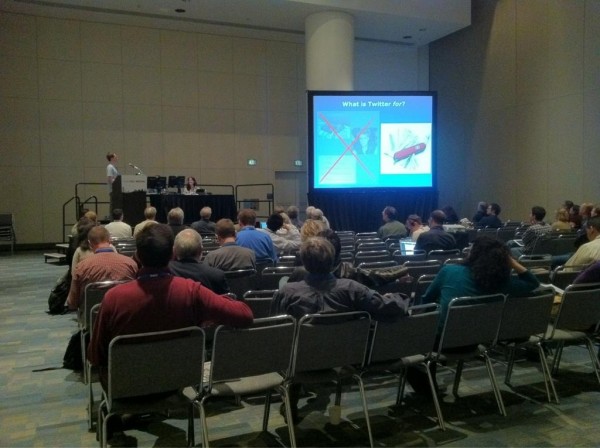![]() There are two main ways to get your science at AGU: by sitting in on one of the dozens of sessions of themed talks, or browsing the monstrous poster hall in Moscone South.
There are two main ways to get your science at AGU: by sitting in on one of the dozens of sessions of themed talks, or browsing the monstrous poster hall in Moscone South.

A view from above of a small fraction of the poster hall in Moscone South. A concentration of awesome science so great, it has it’s own gravitational field.
I spent Tuesday morning mostly wandering around the paleomagnetism posters, and had a great time talking science with the presenters, and also colleagues that I bumped into as they browsed the opposite way. While this was happening, I was noticing a couple of subtle changes in how I was experiencing the whole thing. Firstly, at the posters themselves, I often found myself in the position of being able to offer experience-based advice, because during my own research I’d had that problem, or had used a certain technique for something. It was a nice feeling to think that I was actually being helpful as well as interested. Secondly, I’m now in a position where I know more people in my field, and more importantly, they know me, which meant that the random conversations in the aisle were happening more often. Little things, perhaps, but I enjoyed the feeling that I am becoming a more established part of the scientific community.
This isn’t to say the whole morning was about my self-affirmation: there was plenty of interesting science as well. The most fascinating thing I learnt that I didn’t know before today was that the flood basalts of the Siberian Traps, which are often implicated in the end-Permian extinction 250 million years ago, have been linked geochemically & paleogeographically to the hotspot beneath Iceland. I learnt this in a very interesting chat with Dunia Blanco, who is using this link to try and enhance reconstructions of Siberia’s plate motions since the Permian.
After a morning of science, I moved on to an afternoon of social media evangelism, starting with a session on the uses of social media in science communication. Things kicked off with a series of interesting talks from people involved in fighting out the climate debate, including a star turn from Michael Mann. I was struck, and encouraged, by how people who were well acquainted with some of the worst the internet has to offer were still universally positive about using blogs and social media to communicate science to the public. Then it was time for the less reputable people to get up on stage and pretend they knew what they were talking about.

Yours truly, discussing “the many modes of Twitter”. I can now add showing a picture of Justin Bieber at AGU to my achievement of getting the word “minion” published in Nature. Photo: Cian Dawson
My talk was titled “the many modes of Twitter”, in which I talked about how Twitter can be thought of as a sort of Swiss Army knife – it can be used in a number of different ways for a range of different purposes, and that several of these uses are advantageous for scientists, both for public outreach and interaction with our peers. One of the potential problems with a sessions like this is that I am probably preaching to the mostly-converted, but hopefully people found it useful.
My day ended on a panel discussing the whys and wherefores of science blogging. As ever, it’s hard to know how these things come across to the audience, but the discussion easily filled the allocated hour. Hopefully we convinced some more people to join us in the geoblogosphere.
Then, my job done, I went to the pub. Or, as close as you’re going to get to one in San Francisco. Which might explain why this dispatch is going up on Wednesday morning rather than Tuesday night…



Nice plan for content warnings on Mastodon and the Fediverse. Now you need a Mastodon/Fediverse button on this blog.